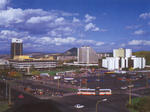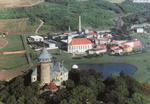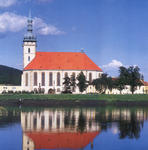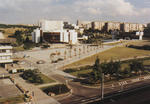 The royal town of Most
The royal town of Most has a history, which is as rich as tragic. Protected by the mighty Gothic castle of Hnevin and the vast water surface of Komoranske jezero, the town was established along an old route from Saxonia to Prague. The name, which translates "bridge", came from a system of bridges that spanned the lake's marshy end. Local archaeological finds may indicate a primeval settlement.
The Cosmas Chronicle mentions a Slavonic market place called Gnevin Pons from 1040 and the first proprietors, the Hrabisic Family.
The Premyslides took over in the 13
th century and a period of rapid development into medieval town was supported by granting many privileges to Most. The citizens of Most drew wealth from trade, crafts and vineyards around, but also suffered from consuming fires and destructive wars. Most could withstand the rage of the Hussite wars undamaged, but suffered heavily during the Thirty-Year War. It was plundered several times by the Swedish troops who also tricked Hnevin's defenders and conquered the castle. Hnevin's fall was final because broken-hearted and angry, the citizens of Most tore the treacherous castle down from atop the hill with the consent of Emperor Ferdinand III. in 1651.
The town was restored, but could acquire its military and business position never again. Three ruinous fires were recorded in the history of Most - 1455, 1515, and 1820. The second fire turned Most literally to ashes. The restoration that followed gave rise to today's prime architectural monuments: the late-Gothic church and
the Renaissance Town Hall. Down to the middle of the 19
th century, the town was, still confined within the walls that yielded only when streets had to become broader. Industrial revolution literally invaded the town bringing in all implicit consequences. Industrial expansion set in the moment Most got connected to the railway in 1870, then mining intensified and Czech population began to stream in, giving an extra impetus to the building business. Industrial companies, mining companies and small mines were sprouting just everywhere. Then a natural disaster struck the town in 1895: shifting sand buried houses with people inside and additional 2,500 became homeless. But the end of the 19
th century brought bustling development of building back to Most. Czech schools appeared after 1918 and the representative Miner's House was added in 1923.
World War Two brought total destruction to Most, which was struck by nine of the sixteen air attacks meant to hit the nearby chemical plant of Hydrierwerke. The build-up of the 1950's centred on new housing for the coming

colonists many of who were gypsies. The tragedy's final part struck in 1964: the old Most was sentenced to yield place to the expanding mines and to be rebuilt as a residential satellite a few miles farther per Government edict.
The only relict of old Most that survived is
the Gothic Virgin Mary Assumption Church built by Jakub Heilmann of Schweinfurt that was cut from the foundations and transferred. The transfer took place between 13
th September and 27
th October 1975 during which time the church travelled 841.1 metres along a curved trajectory at a speed of 2.16 cm per minute. The church and a 12,000 ton supporting steel frame were supported by 53 hydraulic c arriages that equalised every unevenness of the ground within a tolerance range of 1 mm. But it took another 13 years to finish the installation and stabilisation of the structure and to restore the church to its previous beauty. The church was re-opened to public as cultural memorial and original furniture-altar, organ, etc: was not returned until after 1989. The re-opening for religious services and consecration took place in 1993. A National Gallery's exhibition of the plastic art was accommodated in the cellar rooms in 1994. The decanal church is now adjacent to
the old hospital with the small Holy Spirit Church. The most eye - touching building of the new Most is the theatre opened in 1985. Modern attraction for domestic and foreign visitors is the testing and racing car track. The growing district centre of 72,000 continues to be
the heart of the North-Bohemian Brown Coal Mining District even though the exploitation is gradually ceasing. Time has come for Most to find how man and nature can exists in harmony.



 Guide
Guide 





